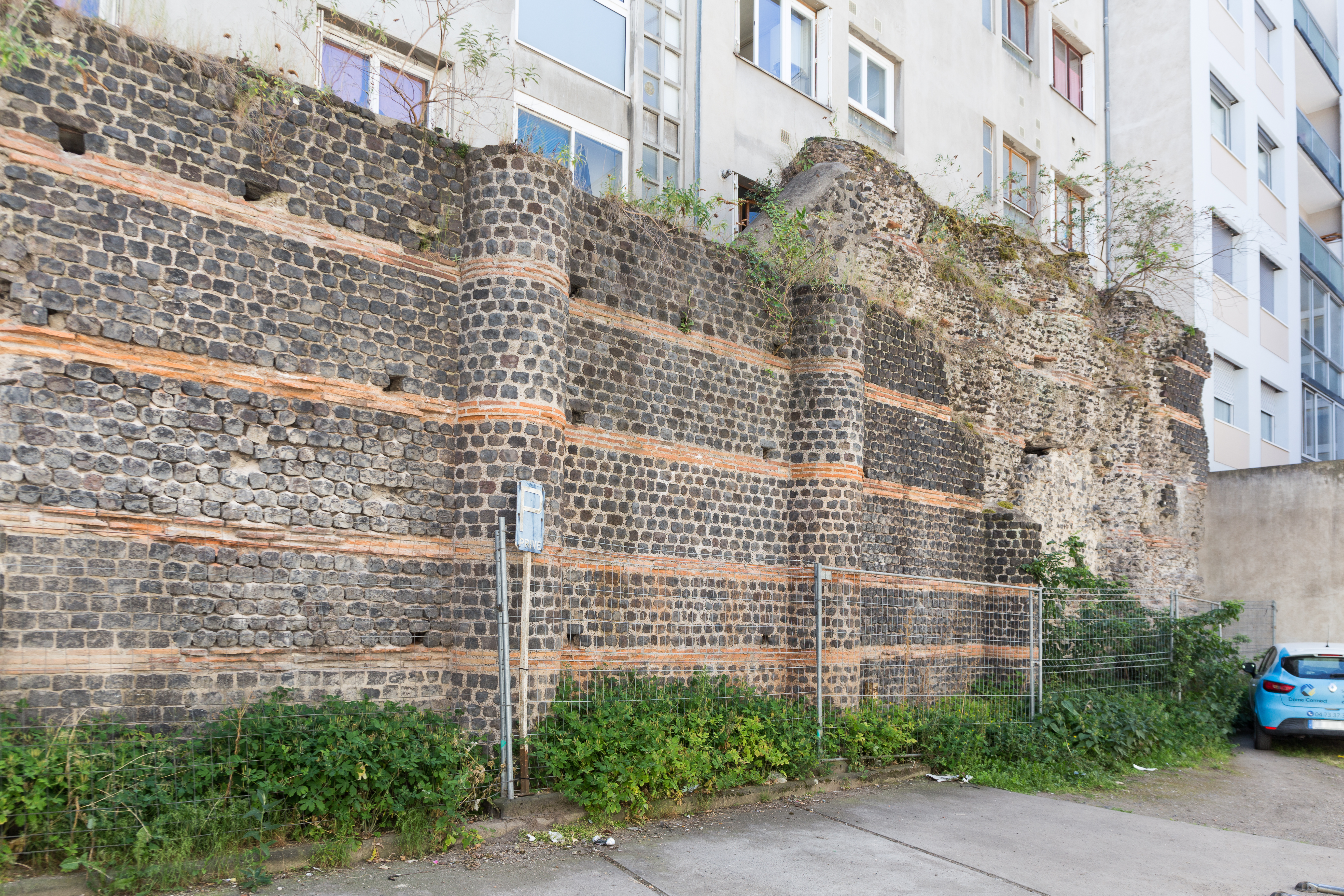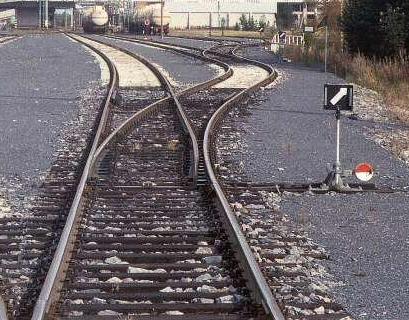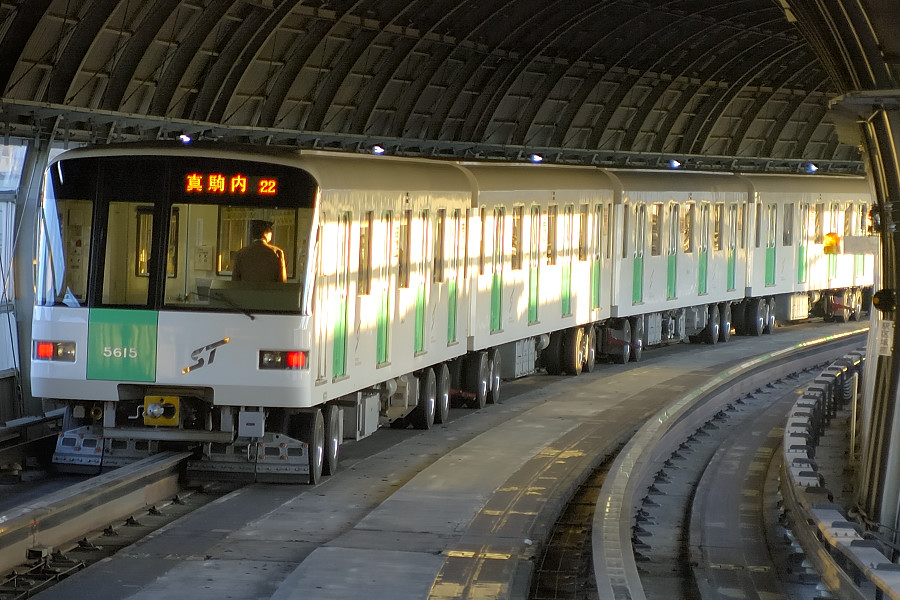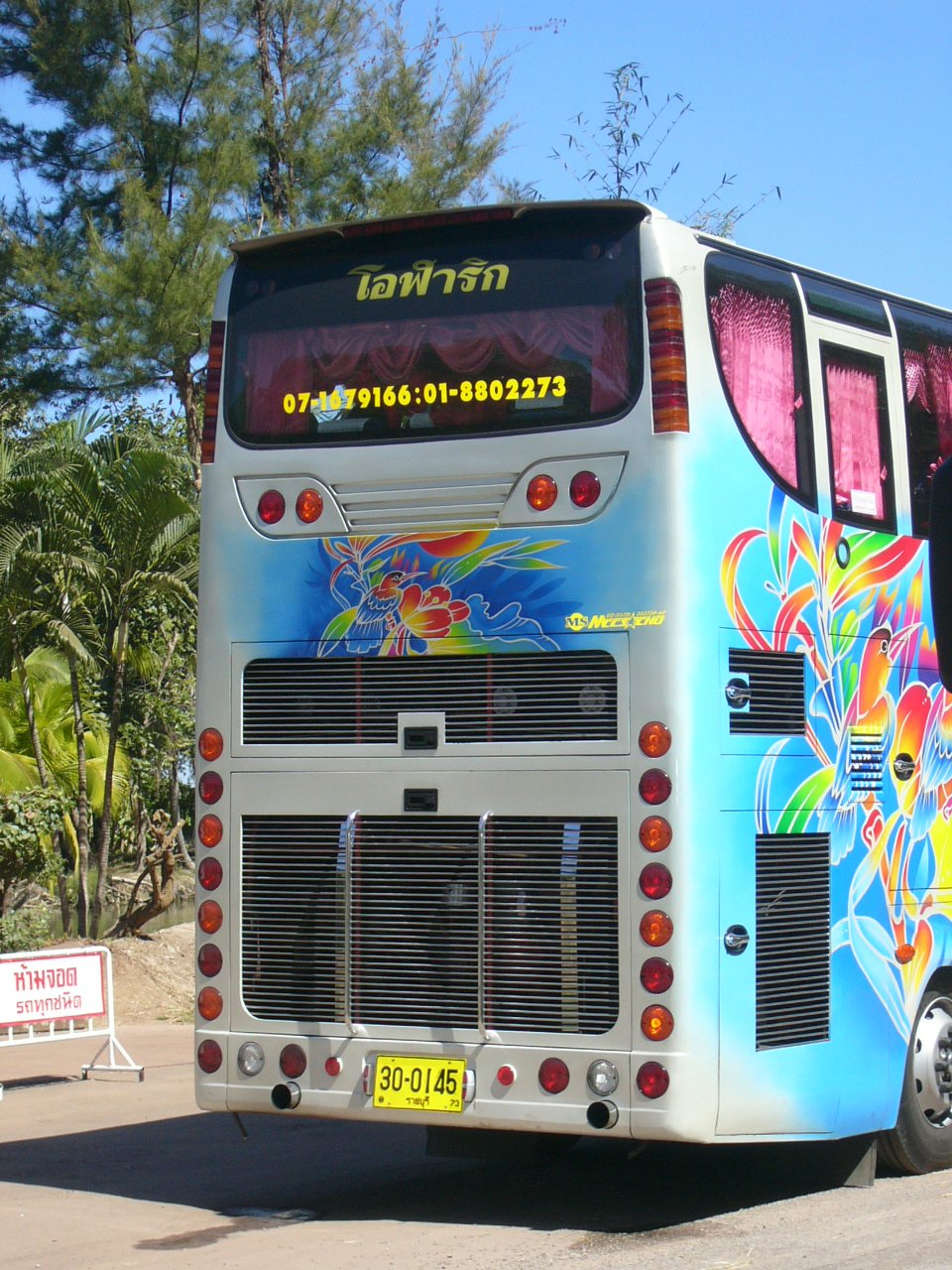|
Rubber-tyred Tram
A rubber-tyred tram (also known as tramway on tyres, ) is a development of the guided bus in which a vehicle is guided by a fixed rail in the road surface and draws current from overhead electric wires (either via pantograph or trolley poles). Two incompatible systems using physical guide rails exist: the guided light transit (GLT) designed by Bombardier Transportation, and the translohr from Lohr Industrie (currently made by Alstom and FSI). There are no guide bars at the sides but there is a central guidance rail that differs in design between the systems. In the case of Translohr, this rail is grasped by a pair of metal guide wheels set at 45° to the road and at 90° to each other. In the GLT system, a single double-flanged wheel between the rubber tires follows the guidance rail. In both cases, the weight of the vehicle is borne by rubber tires to which the guide wheels are attached, which make contact with the road on concrete roll ways designed to minimise impa ... [...More Info...] [...Related Items...] OR: [Wikipedia] [Google] [Baidu] |
Clermont-Ferrand Tram 2024 1
Clermont-Ferrand (, , ; or simply ; ) is a city and Communes of France, commune of France, in the Auvergne-Rhône-Alpes regions of France, region, with a population of 147,284 (2020). Its metropolitan area () had 504,157 inhabitants at the 2018 census.Comparateur de territoire: Aire d'attraction des villes 2020 de Clermont-Ferrand (022), Unité urbaine 2020 de Clermont-Ferrand (63701), Commune de Clermont-Ferrand (63113) INSEE It is the Prefectures in France, prefecture (capital) of the Puy-de-Dôme departments of France, département. Olivier Bianchi is its current List of mayors of Clermont-Ferrand, mayor. Clermont-Ferrand sits on the plai ... [...More Info...] [...Related Items...] OR: [Wikipedia] [Google] [Baidu] |
Battery (electricity)
An electric battery is a source of electric power consisting of one or more electrochemical cells with external connections for powering electrical devices. When a battery is supplying power, its positive terminal is the cathode and its negative terminal is the anode. The terminal marked negative is the source of electrons. When a battery is connected to an external electric load, those negatively charged electrons flow through the circuit and reach the positive terminal, thus causing a redox reaction by attracting positively charged ions, or cations. Thus, higher energy reactants are converted to lower energy products, and the free-energy difference is delivered to the external circuit as electrical energy. Historically the term "battery" specifically referred to a device composed of multiple cells; however, the usage has evolved to include devices composed of a single cell. Primary (single-use or "disposable") batteries are used once and discarded, as the electrode mat ... [...More Info...] [...Related Items...] OR: [Wikipedia] [Google] [Baidu] |
Railroad Switch
A railroad switch (American English, AE), turnout, or (set of) points (Commonwealth English, CE) is a mechanical installation enabling railway trains to be guided from one Rail tracks, track to another, such as at a Junction (rail), railway junction or where a Branch line, spur or Siding (rail), siding branches off. Design The parts of a turnout are known by different names in different jurisdictions. The main terms in U.S. and UK usage are shown in the selectable diagrams. In this article, the U.S. term is listed first and UK second, in parentheses. The most common type of switch consists of a pair of linked tapering rails, known as ''points'' (''switch rails'' or ''point blades''), lying between the diverging outer rails (the ''stock rails''). These points can be moved laterally into one of two positions to direct a train coming from the point blades toward the straight path or the diverging path. A train moving from the narrow end toward the point blades (i.e. it ... [...More Info...] [...Related Items...] OR: [Wikipedia] [Google] [Baidu] |
Derailment
In rail transport, a derailment is a type of train wreck that occurs when a rail vehicle such as a train comes off its rails. Although many derailments are minor, all result in temporary disruption of the proper operation of the railway system and they are a potentially serious hazard. A derailment of a train can be caused by a collision with another object, an operational error (such as excessive speed through a curve), the mechanical failure of tracks (such as broken rails), or the mechanical failure of the wheels, among other causes. In emergency situations, deliberate derailment with derails or catch points is sometimes used to prevent a more serious accident. History The first recorded train derailment in history is known as the Hightstown rail accident in New Jersey that occurred on 8 November 1833. The train was traveling between Hightstown and Spotswood, New Jersey, and derailed after an axle broke on one of the carriages as a result of a journal box catching fir ... [...More Info...] [...Related Items...] OR: [Wikipedia] [Google] [Baidu] |
Rubber-tyred Metro
A rubber-tyred metro or rubber-tired metro is a form of rapid transit system that uses a mix of road transport, road and rail transport, rail technology. The vehicles have wheels with rubber tires that run on a roll way inside guide bars for traction. Traditional, Flange, flanged steel wheels running on rail tracks provide guidance through Railroad switch, switches and act as backup if tyres fail. Most rubber-tyred trains are purpose-built and designed for the system on which they operate. Guided buses are sometimes referred to as 'trams on tyres', and compared to rubber-tyred metros. History The first idea for rubber-tyred railway vehicles was the work of Scotsman Robert William Thomson, the original inventor of the pneumatic tire, tyre. In his patent of 1846 he describes his 'Aerial Wheels' as being equally suitable for, "the ground or rail or track on which they run". The patent also included a drawing of such a railway, with the weight carried by pneumatic main wheels runnin ... [...More Info...] [...Related Items...] OR: [Wikipedia] [Google] [Baidu] |
Tram
A tram (also known as a streetcar or trolley in Canada and the United States) is an urban rail transit in which Rolling stock, vehicles, whether individual railcars or multiple-unit trains, run on tramway tracks on urban public streets; some include segments on segregated Right-of-way (property access), right-of-way. The tramlines or tram networks operated as public transport are called tramways or simply trams/streetcars. Because of their close similarities, trams are commonly included in the wider term ''light rail'', which also includes systems separated from other traffic. Tram vehicles are usually lighter and shorter than Main line (railway), main line and rapid transit trains. Most trams use electrical power, usually fed by a Pantograph (transport), pantograph sliding on an overhead line; older systems may use a trolley pole or a bow collector. In some cases, a contact shoe on a third rail is used. If necessary, they may have dual power systems—electricity in city stre ... [...More Info...] [...Related Items...] OR: [Wikipedia] [Google] [Baidu] |
Automobile Pedal
Car controls are the components in automobiles and other powered road vehicles, such as trucks and buses, used for driving and parking. While controls like steering wheels and pedals have existed since the invention of cars, other controls have developed and adapted to the demands of drivers. For example, manual transmissions became less common as technology relating to automatic transmissions became advanced. Earlier versions of headlights and signal lights were fueled by acetylene or oil. Acetylene was preferred to oil, because its flame is resistant to both wind and rain. Acetylene headlights, which gave a strong green-tinted light, were popular until after World War I; even though the first electric headlights were introduced in 1898 (and those were battery-powered), it wasn't until high-wattage bulbs and more powerful car electrical generating systems were developed in the late 1910s that electric lighting systems entirely superseded acetylene. Steering The first automo ... [...More Info...] [...Related Items...] OR: [Wikipedia] [Google] [Baidu] |
Steering Wheel
A steering wheel (also called a driving wheel, a hand wheel, or simply wheel) is a type of steering control in vehicles. Steering wheels are used in most modern land vehicles, including all mass-production automobiles, buses, light and heavy trucks, as well as tractors and tanks. The steering wheel is the part of the steering system that the driver manipulates; the rest of the steering system responds to such driver inputs. This can be through direct mechanical contact as in recirculating ball or rack and pinion steering gears, without or with the assistance of hydraulic power steering, HPS, or as in some modern production cars with the help of computer-controlled motors, known as Power steering#Electric systems, electric power steering. History Near the start of the 18th century, many sea vessels appeared using the ship's wheel design. However, historians are unclear when that approach to steering was first used. The first automobiles were steered with a Tiller (automobi ... [...More Info...] [...Related Items...] OR: [Wikipedia] [Google] [Baidu] |
Vehicle Registration Plate
A vehicle registration plate, also known as a number plate (British, Indian and Australian English), license plate (American English) or licence plate (Canadian English), is a metal or plastic plate attached to a motor vehicle or trailer for official identification purposes. All countries require registration plates for commercial road vehicles such as cars, trucks, and motorcycles, for hire. Whether they are required for other vehicles, such as bicycles, boats, or tractors, may vary by jurisdiction. The registration identifier is a numeric or alphanumeric ID that uniquely identifies the vehicle or vehicle owner within the issuing region's vehicle register. In some countries, the identifier is unique within the entire country, while in others it is unique within a state or province. Whether the identifier is associated with a vehicle or a person also varies by issuing agency. There are also electronic license plates. Legal requirements In Europe, most governments requi ... [...More Info...] [...Related Items...] OR: [Wikipedia] [Google] [Baidu] |
Automotive Lighting
Automotive lighting is functional exterior lighting in vehicles. A motor vehicle has lighting and signaling devices mounted to or integrated into its front, rear, sides, and, in some cases, top. Various devices have the dual function of illuminating the road ahead for the driver, and making the vehicle visible to others, with indications to them of turning, slowing or stopping, etc., with lights also indicating the size of some large vehicles. Many emergency vehicles have distinctive lighting equipment to warn drivers of their presence. History Early road vehicles used fuelled lamps before the availability of electric lighting. The first Ford Model T used carbide lamps for headlights and oil lamps for tail lights. It did not have all-electric lighting as a standard feature until several years after its introduction. Dynamos for automobile headlights were first fitted around 1908 and became commonplace in 1920s automobiles. Trafficators—signalling arms that flipped up, ... [...More Info...] [...Related Items...] OR: [Wikipedia] [Google] [Baidu] |









